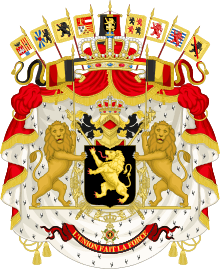Castle of Laeken
| Castle of Laeken | |
|---|---|
|
Kasteel van Laken (in Dutch) Château de Laeken (in French) Schloss Laken (in German) | |
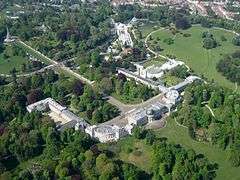 Castle of Laeken and park from the air | |
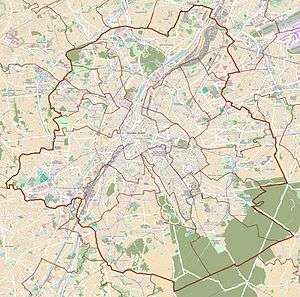 Location within Brussels | |
| General information | |
| Town or city | Laeken (Brussels) |
| Country | Belgium |
| Construction started | 1782 |
| Client | Governors of the Habsburg Netherlands, Archduchess Maria Christina of Austria and her husband Albert of Saxe-Teschen |
| Owner | Belgian State |
| Design and construction | |
| Architect | Charles de Wailly |
| Engineer | Louis Montoyer |
The Castle of Laeken (Dutch: Kasteel van Laken, French: Château de Laeken; actually a palace, not a castle), is the official residence of the King of the Belgians and the royal family. It lies in the Brussels region, 5 km (3 mi) north of the city centre in the municipality of Laeken. It sits in a large park called the Royal Domain of Laeken, which is off-limits to the public. It was originally named the Castle of Schonenberg and is often referred to as the Royal Castle.
The castle at Laeken should not be confused with the Royal Palace of Brussels, in central Brussels, which is the official palace (not residence) of the King of the Belgians and from which affairs of state are handled.
History
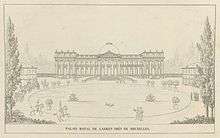
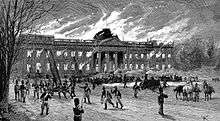
The castle was built at Laeken, then outside of Brussels, between 1782-1784 after the plans of the French architect Charles de Wailly under supervision of Louis Montoyer as a summer residence for the Governors of the Habsburg Netherlands, Archduchess Maria Christina of Austria and her husband Albert of Saxe-Teschen. Jean-Joseph Chapuis provided the royal furniture.
On 21 July 1803, Nicolas-Jean Rouppe, as commissioner of the department of the Dyle, received Napoleon at the Castle of Laeken. Napoleon stayed at Laeken with the Empress Josephine in August 1804 on his way from awarding the first Légion d'honneur to his invasion troops at Boulogne to his progress along the Rhine, and later during the Hundred Days in 1815 dated this proclamation prematurely from the palace:
| “ | To the Belgians and the inhabitants of the left bank of the Rhine. The ephemeral success of my enemies detached you for a moment from my empire. In my exile, upon a rock in the sea, I heard your complaint; the God of Battles has decided the fate of your beautiful provinces; Napoleon is among you; you are worthy to be Frenchmen. Rise in a body; join my invincible phalanxes to exterminate the remainder of these barbarians, who are your enemies and mine: they fly with rage and despair in their hearts. | ” |
| — The Imperial Palace of Lacken, 17 June 1815. (Signed) Napoleon, The Imperial Palace of Lacken, 17 June 1815. By the Emperor, The Major-General of the Army, Count Bertrand."[1] | ||
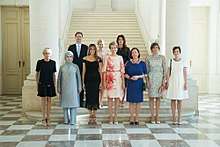
.jpg)
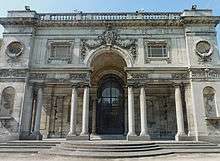
After Belgian independence, Rouppe, as mayor of Brussels, received the new king Leopold I at the Castle of Laeken on 21 July 1831; the day of Leopold's coronation. The palace was partly destroyed by fire in 1890 and was rebuilt by Alphonse Balat. The French architect Charles Girault gave it its present outline in 1902. It has been the royal residence since Leopold I's accession to the throne in 1831. The domain also contains the magnificent Royal Greenhouses of Laeken, a set of monumental dome-shaped constructions, accessible to the public for a few days each year. They were designed as well by Alphonse Balat, with the cooperation of the young Victor Horta.
Upon their accession to the throne in 1993, King Albert II and Queen Paola preferred to remain living at Belvédère, a château on the grounds of the park surrounding the Castle. The current occupants of the Castle are King Philippe, Queen Mathilde and their four children.
Royal Garden of Laeken
The royal estate is surrounded by an immense garden, which is protected by a stone wall of several kilometres. The gardens are designed in English style; the vast parks of the Royal Domain include lakes, a golf course and artworks. Leopold II of Belgium was very closely connected with the designs of his private gardens. In the gardens his only son, Prince Leopold, Duke of Brabant, fell in a pond, and died subsequently from pneumonia, aged only nine. The king had trees planted for his newborn children, which still stand in the park.
There are various pavilions, including the Chinese Pavilion and the Japanese Tower. They were commissioned by King Leopold II and now form part of the Museums of the Far East. The rooms of the Chinese Pavilion are designed in a chinoiserie Louis XIV and Louis XVI Style. They are decorated with Chinese motifs, chinaware and silverware. The Japanese Tower is a pagoda.
Today only the king himself and his children use the garden, generally the gardens are closed to the public. The greenhouses and the gardens are famous for their unique varieties of trees.
In the gardens several colonies of wild Canada geese, hundreds of cormorants and other large birds live. The gardens are home to one of the biggest colonies of herons in the country. [2]
Other
Mobutu Sese Seko, the dictator of Zaire (the modern-day Democratic Republic of the Congo), built a palace in his hometown of Gbadolite modelled upon the Royal Castle of Laeken.[3]
Gallery
- Main facade
 A carriage at the Royal mews of Laeken
A carriage at the Royal mews of Laeken.jpg)


See also
References
External links
![]()
- The Royal Castle of Laeken at Visit Brussels
